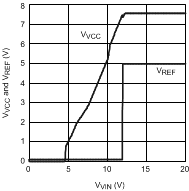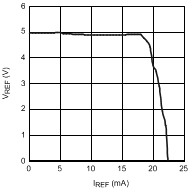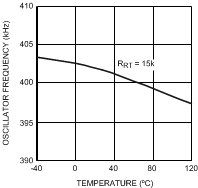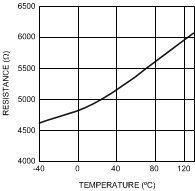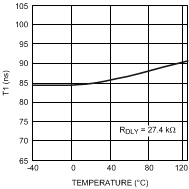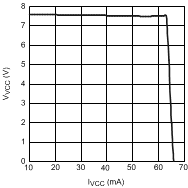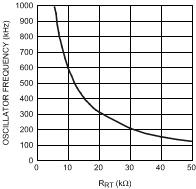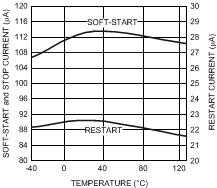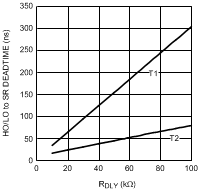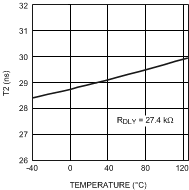SNVS631D January 2010 – October 2016 LM5035C
PRODUCTION DATA.
- 1 Features
- 2 Applications
- 3 Description
- 4 Revision History
- 5 Device Comparison Table
- 6 Pin Configuration and Functions
- 7 Specifications
-
8 Detailed Description
- 8.1 Overview
- 8.2 Functional Block Diagram
- 8.3
Feature Description
- 8.3.1 High-Voltage Start-Up Regulator
- 8.3.2 Line Undervoltage Detector
- 8.3.3 Line Overvoltage, Load Overvoltage, and Remote Thermal Protection
- 8.3.4 Reference
- 8.3.5 Cycle-by-Cycle Current Limit
- 8.3.6 Overload Protection Timer
- 8.3.7 Soft Start
- 8.3.8 PWM Comparator
- 8.3.9 Feedforward Ramp and Volt • Second Clamp
- 8.3.10 Oscillator, Sync Capability
- 8.3.11 Gate Driver Outputs (HO and LO)
- 8.3.12 Synchronous Rectifier Control Outputs (SR1 and SR2)
- 8.3.13 Thermal Protection
- 8.4 Device Functional Modes
- 9 Application and Implementation
- 10Power Supply Recommendations
- 11Layout
- 12Device and Documentation Support
- 13Mechanical, Packaging, and Orderable Information
封装选项
机械数据 (封装 | 引脚)
散热焊盘机械数据 (封装 | 引脚)
- PWP|20
订购信息
7 Specifications
7.1 Absolute Maximum Ratings
over operating free-air temperature range (unless otherwise noted)(1)(2)| MIN | MAX | UNIT | ||
|---|---|---|---|---|
| VIN to GND | –0.3 | 105 | V | |
| HS to GND | –1 | 105 | V | |
| HB to GND | –0.3 | 118 | V | |
| HB to HS | –0.3 | 18 | V | |
| VCC to GND | –0.3 | 16 | V | |
| RT, DLY to GND | –0.3 | 5.5 | V | |
| COMP input current | 10 | mA | ||
| CS | 1 | V | ||
| All other inputs to GND | –0.3 | 7 | V | |
| Junction temperature | 150 | °C | ||
| Storage temperature | –65 | 150 | °C | |
(1) Stresses beyond those listed under Absolute Maximum Ratings may cause permanent damage to the device. These are stress ratings only, which do not imply functional operation of the device at these or any other conditions beyond those indicated under Recommended Operating Conditions. Exposure to absolute-maximum-rated conditions for extended periods may affect device reliability.
(2) If Military/Aerospace specified devices are required, contact the Texas Instruments Sales Office/ Distributors for availability and specifications.
7.2 ESD Ratings
| VALUE | UNIT | |||
|---|---|---|---|---|
| V(ESD) | Electrostatic discharge | Human-body model (HBM), per ANSI/ESDA/JEDEC JS-001(1) | ±1500 | V |
| Charged-device model (CDM), per JEDEC specification JESD22-C101(2) | ±250 | |||
(1) JEDEC document JEP155 states that 500-V HBM allows safe manufacturing with a standard ESD control process.
(2) JEDEC document JEP157 states that 250-V CDM allows safe manufacturing with a standard ESD control process.
7.3 Recommended Operating Conditions
over operating free-air temperature range (unless otherwise noted)(1)| MIN | NOM | MAX | UNIT | ||
|---|---|---|---|---|---|
| VIN voltage | 13 | 105 | V | ||
| External voltage applied to VCC | 8 | 15 | V | ||
| Operating junction temperature | –40 | 125 | °C | ||
(1) Absolute Maximum Ratings are limits beyond which damage to the device may occur. Operating Ratings are conditions under which operation of the device is intended to be functional. For ensured specifications and test conditions, see Electrical Characteristics.
7.4 Thermal Information
| THERMAL METRIC(1) | LM5035C | UNIT | ||
|---|---|---|---|---|
| PWP (HTSSOP) | NHZ (WQFN) | |||
| 20 PINS | 24 PINS | |||
| RθJA | Junction-to-ambient thermal resistance | 35.9 | 31.3 | °C/W |
| RθJC(top) | Junction-to-case (top) thermal resistance | 19.8 | 25 | °C/W |
| RθJB | Junction-to-board thermal resistance | 16.7 | 9.9 | °C/W |
| ψJT | Junction-to-top characterization parameter | 0.4 | 0.2 | °C/W |
| ψJB | Junction-to-board characterization parameter | 16.6 | 10.1 | °C/W |
| RθJC(bot) | Junction-to-case (bottom) thermal resistance | 1.6 | 1.6 | °C/W |
(1) For more information about traditional and new thermal metrics, see the Semiconductor and IC Package Thermal Metrics application report.
7.5 Electrical Characteristics
Specifications with standard typeface are for TJ = 25°C, unless indicating that type applies over full operating junction temperature range. VVIN = 48 V, VVCC = 10 V externally applied, RRT = 15 kΩ, RDLY = 27.4 kΩ, VUVLO = 3 V, VOVP = 0 V unless otherwise stated. See (1) and (2).
(1) All limits are ensured. All electrical characteristics having room temperature limits are tested during production with TA = 25°C. All hot and cold limits are ensured by correlating the electrical characteristics to process and temperature variations and applying statistical process control.
(2) Typical specifications represent the most likely parametric norm at 25°C operation
7.6 Typical Characteristics
